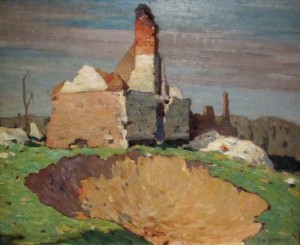
The Sunken Road (1919) by Frederick Varley. Beaverbrook Collection of War Art, Canada War Museum. Photo by Mark Skeffington.
The First World War was a horror, destroying millions of lives in epic proportion.
Yet, as the irony of human nature would have it, the Great War also led to the creation of great art, including monumental and moving works by many of Canada’s best painters of the day.
That art has been deservedly and proudly put on display at the Canadian War Museum in Ottawa.
Witness – Canadian Art of the First World War is one of two art exhibits front and centre at the Museum (the other being Transformations: A.Y. Jackson and Otto Dix, Art Shaped by War; both closed Sept. 26.).
The exhibit, which marks the 100th centenary of the start of the First World War, showcases key pieces from the Museum’s impressive Beaverbrook Collection of War Art, which numbers some 13,000 paintings, drawings and sculptures.

A Shell Hole by J.W. Beatty (1917-19). Beaverbrook Collection of War Art, Canadian War Museum. Photo by Mark Skeffington
Although only a fraction is on display, the exhibit reminds us of two important things:
First, many of Canada’s top artists of the day painted scenes from the front or from the war effort back home, with the war impacting them deeply.
Second, you didn’t have to be a professional artist to tell the story of war; many “soldier artists” created artworks that were equally moving.
Many of the artworks would never have been created if not for one man: Lord Beaverbrook, Canadian Max Aitken, who had the influence and foresight to create the Canadian War Memorials Fund in 1916.
It was Beaverbrook who hired 100 British and Canadian artists – at first the British far outnumbered the Canadians – to paint the war, serving as witnesses, recorders, storytellers, history keepers.
Some of the Canadian artists were recruited by Beaverbrook after they fought and were wounded: A.Y. Jackson and Kenneth Forbes being prime examples.
Others went to the front in France and Belgium directly from Canada as official war artists: J.W. Beatty, Frederick Varley, Maurice Cullen, Charles Simpson and others.
It is amazing, especially considering war censorship, that these artists were given such a free hand to record the horrors of the trenches and the aftermath of battles.

Detail from Ablain-Saint-Nazaire (1918) by J.W. Beatty. Beaverbrook Collection of War Art, Canadian War Museum. Photo by Mark Skeffington
But they were just doing their job: they were hired to capture the horrors of war, so they faithfully did.
Frederick Varley’s The Sunken Road (1919) doesn’t shy away from anything, depicting dead and decapitated German soldiers, lying atop mud and trenches churned up by bombs. Varley’s For What? showing a cart full of bodies waiting to be buried beneath tiny white crosses, is even more bluntly condemning of war.
A.Y. Jackson, J.W. Beatty, James Kerr-Lawson and others painted tortured trench-crossed fields, earth ripped apart by giant shells, and artillery-pounded villages, churches and homes: scenes where signs of civilization had all but vanished.
Others Canadian artists, such as David Milne and James Wilson Morrice, made it to the front after the November 1918 Armistice, coming face to face with an unearthly war-torn landscape that challenged the senses and heart.

Olympic with Returned Soldiers by Arthur Lismer (1919). Beaverbrook Collection of War Art, Canadian War Museum. Photo by Mark Skeffington
Still other Canadian artists recorded Canada’s war efforts at home: Homer Watson painting a training camp in Quebec, Franz Johnston pilot training above the Niagara escarpment, and Albert Robinson and Robert Gagen shipbuilding.
Arthur Lismer painted the arrival of the ship Olympic returning home to Halifax carrying 5,300 soldiers prior to Christmas 1918. There were also opportunities for women artists, with Mabel May painting women making munitions Women Making Shells (1919).
Some of these home front works were patriotic, but most avoided being propagandistic.
Many of the works created by official war artists were grand in scale, in keeping with the history-making events they depicted. For example, Charles Simpson’s Lumbering Aeroplane Spruce in B.C. (1919) measures 4 by 12 feet. Others, such as J.W. Beatty’s A Shell Hole (1917-19) at 25 by 30 inches, were more modest in scale.
To its credit, the Canadian War Museum gives equal billing to soldier artists and professional artists in Witness, and in its 117-page souvenir catalogue.
One exhibit drawback is that some of the larger works have been mounted so high on the museum’s concrete walls, along the passage leading to the LeBreton Gallery of weapons, that they can’t be fully appreciated. One such work is Maurice Cullen’s No Man’s Land (1920).
We’re privileged to witness the cataclysm of the First World War through the eyes of so many artists, from Canadian masters to soldiers in the trenches.
– Mark Skeffington, FineArtCollector.ca
Copyrighted material. Cannot be used without written permission.
For more information on Witness: Canadian Art of the First World War visit the Canadian War Museum’s website.